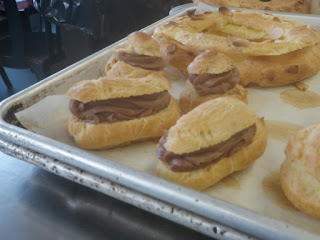 |
| Rick Bayless |
The first thing he talked about was the difference between Mexican food and the rest of the world. Most cuisines want you to taste every ingredient that goes into a dish. Mexican cooking wants to combine the flavors so thoroughly that it is a new taste. Ah. He mentioned mole. He said that most people know one mole. But, he continued, there are at least seven, and within these there are many variations. So he did 2 moles for us, coloradito and verde. He did a wonderful job of explaining the proper chile prep (the dried chilis, like ancho and guajillo in the first recipe need to be flexible when you buy them). First you need to open them up, toast them on a dry surface, then rehydrate them. Other ingredients are toasted (garlic and tomatoes) in a fry pan covered with tin foil and put in the oven. After they get toasted he removes the skin from the tomatoes. Then he puts the chilis and the tomato and the garlic in a blender. Then adds toasted sesame seeds, Mexican oregano (not related to Mediterranean oregano), cinnamon, black pepper, little chicken broth and chopped Mexican chocolate. He likes to blend for at least 5 minutes. Then the ingredients are strained, fried in lard until it is tomato paste thickness. Chicken stock is added and it is left on the stove to simmer for several hours. Then salt and sugar is added.
He also did a green mole with tomatillos and toasted almonds.
Heavenly.

















